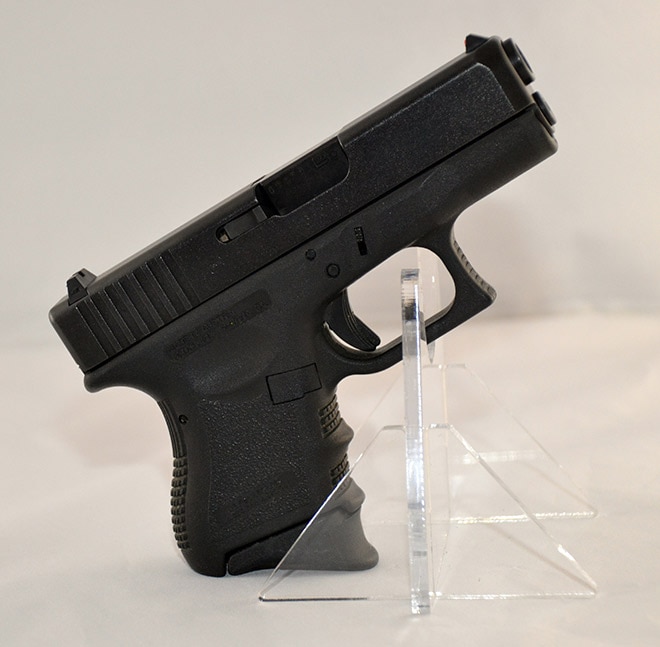
My used 9mm Glock 26 concealed carry handgun which was purchased for $350. (Photo: Mike Garman)
A while back, Guns.com contributor Kenny Hatten reviewed the then new Gen 4 Glock 26. As Kenny says, Glocks are forever but they don’t always stay with the original owner. In this case I came across a Gen 3 Glock 26 with 4 magazines, and all of the original paperwork for $350.
A cursory examination revealed a little wear on the exterior of the barrel and on the slide release. There is no wear on the slide itself from being carried — at the asking price it was too good to pass up.

It was only after I broke it down that I discovered some areas of concern. (Photo: Mike Garman)
After getting the G26 home and stripping it down, I found some areas of concern. As it was, it would make a perfectly fine shooter and would probably make a good everyday carry gun (EDC). But there are a couple of areas the needed some work and, since is was to be used by my friend Tara for a defensive handgun class, I wanted to make sure it was as good as it can be.
The first issue was the guide rod and recoil spring: with the slide locked back there was a large amount of play or slop in the barrel. Granted, there should be some, but I felt that this was excessive. This is as much due to the cheap plastic guide rod and springs used by Glock as it is to wear from shooting it. This was easily taken care of with a stainless steel guide rod and spring assembly by Rock Your Glock and about two minutes to install.

Rock Your Glock guide rod and spring, top, Glock 26 guide rod and spring, bottom. (Photo: Mike Garman)
The second problem was the mag release. It is very short and the size of the grip makes it very difficult to hit the mag release. I can’t press it with my strong hand thumb, I have to rotate the gun to fully address the release with use my support hand. If it’s hard for me to manipulate it would be almost impossible for Tara who is left handed. While that is not a problem on the range, in a gunfight it could be very bad. Several aftermarket companies, as well as Glock, make an extended mag release that’s fairly easy to operate. I did this as part of the trigger upgrade, which brings me to the trigger.

Extended magazine release from Glock. (Photo: Mike Garman)
Like many, I don’t like the factory Glock trigger. There is a lot of slack in it and, when it came to this used G26, a lot of slop (slop is movement in the trigger that doesn’t have anything to do with firing the weapon. It usually comes with wear from shooting the weapon a lot). I think a certain amount of slack or take up in a handgun trigger is normal, but the factory Glock trigger simply has too much.

Lone Wolf trigger kit. (Photo: Mike Garman)
As with the magazine release there are plenty of aftermarket triggers available. I use a Lone Wolf trigger set up in my Glock 22 race gun. It gives me the feel that I like, it’s easy to install and very affordable. The kit from Lone Wolf consists of: Lone Wolf 3.5# connector, Lone Wolf weight striker spring, Lone Wolf 6# trigger spring and a Lone Wolf Ultimate trigger stop
Installing a trigger upgrade in a Glock is pretty straightforward and does not take a master gunsmith. There are plenty of videos on YouTube on how to do it but if you are not confident in your abilities to disassemble the trigger assemblies of your Glock, take it to a gunsmith.

Rock Your Glock stainless steel guide rod installed. (Photo: Mike Garman)
The original price for this used G26 was $350 and at the price it makes a good range, backup or EDC gun. Add to that a Rock Your Glock Stainless Steel Guide Rod, $41.00, a Glock extended magazine release, $3.49, and a Lone Wolf “Pro Pick” trigger kit, $36.00. Also add about 30 minutes of work replacing the parts and this used Glock 26 goes from a decent shooter to an exceptional one that can be used for EDC, backup gun competition or home defense. My conclusion is to never be afraid to look on the used market for your next firearm purchase — just be ready to put in a little extra.
The post My Glock 26, or the perils of and solutions to buying a used handgun appeared first on Guns.com.
